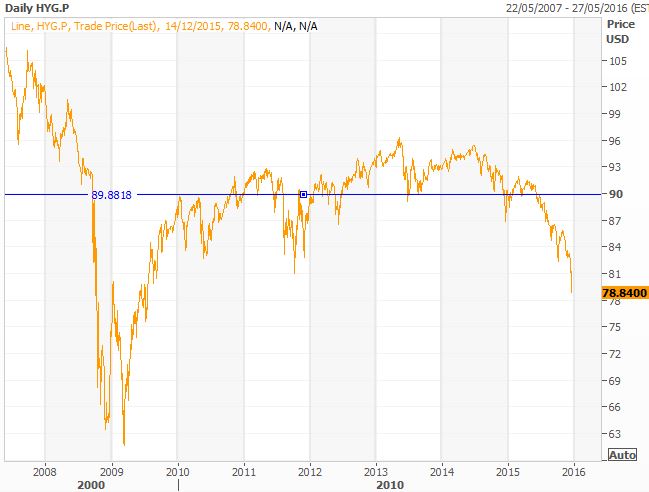One of the main topics of discussion in financial circles these days seems to be liquidity. In many markets liquidity (the amount of buyers and sellers in the market) has reduced significantly since the beginning of the financial crisis in 2008.
Gone are the days when all of the banks and broker dealers had all of their fingers in all of the pies. Over the last few years as banks have been forced to consolidate, pulling out of ‘non core’ businesses in an attempt to stick to what they know best and maximize profits rather than revenues. While this behavior is certainly in the interests of individual banks it can have some other consequences for the markets in general.
The result is a huge lack of liquidity in the market. This can be evidenced by recent high yield credit fund redemptions .
The above chart shows the iBoxx High Yield Corporate Bond ETF. What is clear is that HY credit markets are having a major wobble. The sustained environment of low interest rates has meant investors have sought high yield assets over the last few years in order to earn reasonable returns. Meanwhile on the other side of the trade corporates, many of dubious quality have been loading up on cheap debt while they can. Sound familiar?
What is really interesting on the above chart is the blue line. The index was at this level on the 15th September 2008 when Lehman Brother filed for bankruptcy. As you can see we are well below those levels today….nearly halfway down the slop of the 2008/2009 credit crisis.
Don’t Catch Falling Knives
The last financial crisis was caused because the toxic derivatives that all the banks owned started losing money. Nobody knew who owned what and who would go bust next so liquidity all but dried up. When that happens, prices free fall like they did in 2008.
While complex derivative products are far less common place these days (when was the last time you heard of a CDO2?) there is now a new threat to liquidity in the market that might just spark a new crisis.
Back in the pre crisis days, when prices were gapping down banks would/could buy assets if they thought sell them on to clients and make a spread or even buy them and hold them on their balance sheets until they recovered and could be sold at a profit.
The swathes of financial regulation that have gone live in the last few years have changed the rules of the game. Legislation such as Volcker now prevents banks from taking proprietary risk positions onto their books. In addition Basel 3/CRD4 regulation means that banks are heavily constrained in terms of capital consumption and available balance sheet. The result is that even if they wanted to buy falling assets they cannot.
What does this mean?
Well for the above chart I believe the chances of a sudden collapse in HY credit markets is very likely. It won’t take much (even lower oil, even slower China, something Middle Eastern, bad US data, more defaults, another recession…take your pick) to set off the contagion.
There is a lot of HY debt out there that will need to be refinanced in the coming years and if there are not enough buyers around then prices will take an even more dramatic fall southwards. Due to markets being a lot less liquid than they used to be it’ll mean we have a new credit crisis on our hands.


How is it possible that the bad news is not priced in now? Is the hy bond market very inefficient?
Marco,
It’s impossible for everything to be ‘priced in’ because the reality is nobody knows what is going to happen tomorrow. The point I was trying to make was that with far less liquidity in markets, the potential for amplified downward moves is far greater than it used to be pre crisis. In this respect I’d argue that HY bond markets aren’t very ‘efficient’.